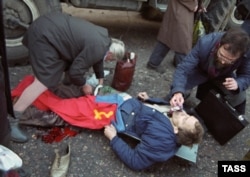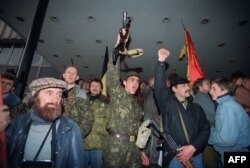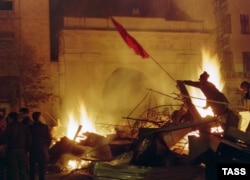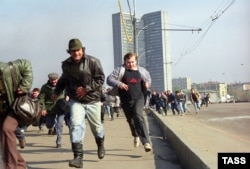It has been 25 years since the culmination of the so-called Russian constitutional crisis, when the country's president, Boris Yeltsin, sought to dissolve the parliament and then ordered the military to crush opposition led by the vice president at the time, Aleksandr Rutskoi, and the chairman of parliament, Ruslan Khasbulatov.
I was working in Central Asia when the crisis broke out in September 1993, and heard bits and pieces from Radio Mayak every now and again from the Uzbek village I was working in at the time.
I traveled regularly to Moscow for my job -- heading a Central Asian sociology project for the University of Manchester and the Soros International Fund for Cultural Initiative -- to hand over material from our Central Asian colleagues, pick up their salaries, and restock my own household supplies for the next period of village life.
By chance, I arrived in the Russian capital on October 1. Friends there explained the rapidly changing situation. (I was more interested in the party that some friends told me was set for the Penta Hotel on Saturday night, October 2.)
I had my first look at the Russian parliament building, known as the White House, on the way to the Penta. It was surrounded by trucks, the Soviet-era tanker trucks that had big letters on the sides showing they carried moloko (milk) or voda (water), or something. There was also barbed wire around the building. Small groups of people were milling about on both sides of the barricade.
Sunday, October 3, was shopping day for me. There were always too many people at the Irish store on the Arbat on the weekend, but there was another Irish store on the Ring Road. There was a smaller selection but I was only looking for basic products, like toilet paper.
'Some Snap Drill'
Just before I reached the store, a convoy of Russian military trucks full of soldiers drove by. They were moving rather fast. I didn't think too much of it. I'd seen military convoys drive through cities before, especially in Moscow. "Some snap drill," I thought.
I hadn't been back at my accommodation long when the phone rang. It was an Italian friend, Ferrante. He was doing business in Russia and lived not far from the flat I stayed in when I was in Moscow. We knew each other from parties and had seen each other at the Penta on Saturday night.
Our conversation went something like this:
"Are you watching this?" he asked.
"Watching what? I just got back," I replied, "What's going on?"
"There's shooting at Ostankino," Ferrante said in reference to the TV tower. "It's on CNN. Come over."
Now I knew what the military trucks were doing. I hurried over to Ferrante's place and sat down to watch.
"Here," Ferrante said, handing me a shot of vodka.
We both downed the shot and watched, then downed another shot, and watched.
We were also listening to a local radio station, and Ferrante was getting calls from people around Moscow. It was clear Ostankino was not the only place where serious events were unfolding.
Ferrante poured us both another shot. We downed it and Ferrante started speaking.
"You know," and he paused. It seemed like a long pause, then he said exactly what I was thinking: "I always wished I was here in 1991," a reference to the events that brought about the collapse of the Soviet Union. "Something big is happening. Let's go out and see."
Ferrante called his Russian driver to come over and get us, and we headed to the parliament building just as the sun was setting.
And Then It Got Weird
We had trouble reaching the area. Some streets were blocked off. Once, our car turned a corner and there was a group of around 50 men marching toward us carrying sticks and crowbars. "Go back," Ferrante yelled, though the driver was already trying.
We parked by the Hotel Ukraina, across the Moscow River from the parliament building. The bridge across the river was barricaded on the side near the parliament building but pedestrians could pass easily enough. We walked around watching apparent supporters of Rutskoi and Khasbulatov turn over those tanker trucks, light fires, and rearrange the barbed wire.
There was lots of drinking everywhere.
The crowd was growing. Men in military uniforms had arrived carrying a Soviet flag, and they were trying to form a column of several hundred of the seemingly hard-drinking supporters of Rutskoi and Khasbulatov. It was clear things were about to get ugly.
We noticed and were already talking, in English, about departing. I lit a cigarette, and a Russian man who had obviously had a few shots of vodka himself approached me and asked for a light. After I lit his cigarette, he stared at us and said, "Well guys, are we going, or are we going to sit here taking a piss?"
"Sit here taking a piss," I replied immediately. "Sorry, we're foreigners and this isn't our fight."
That was enough for him, and he left.
So did we. Back across the river to the Metro, which, amazingly, was working. It was packed, but we were easily able to make it to Tverskoi Boulevard, where the pro-Yeltsin side was assembling. They were drinking, too, but there were places where the atmosphere was more party than political upheaval. I remember a truck lay overturned and there was a guy on top of it playing the accordion and singing with a voice like iconic balladeer Vladimir Vysotsky. A lot of people were just sitting around on the street, drinking and talking.
I got back to my apartment at about 3:00 a.m. "What would daylight bring?" I wondered.
The phone woke me up on Monday, October 4. It was Ferrante again.
"I just got back from the center. I was on the bridge when the tank fired at parliament," he said quickly.
A Lot To Digest
It was a lot for me to digest, first thing out of bed. There was an assault on the parliament building, a lot of shooting, people killed...
As I sat at the table drinking tea, more calls came in from friends. Did I know what happened? Had I heard? What had I heard? They told me what they heard.
Several people called just to see where I was, since they knew I was in Moscow but I had not answered the phone all Sunday night.
I remember best the call from my friend Samuel. "Where were you last night?"
When I told him I had been out roaming around in both camps, he screamed, "Are you totally stupid? People are getting killed out there."
The call ended with me promising I wouldn't leave my apartment. And I would have kept that promise if I had not run out of sugar for my tea.
I figured the odds of finding someone selling sugar were probably not so good in such times, but I don't like tea without sugar, so I headed out and got on the subway, which was still running, and went to the Arbat stop.
There was no traffic on the road. I tried walking to where the Irish store on the Arbat was located, but that side of the street was blocked off. On the other side of the street, there was a long line of people behind metal barriers, so I crossed to see. The crowd stretched all the way down the road in the direction of the Moscow River until the about the last 100 meters from the intersection where the Aeroflot globe was. The other side of the intersection was the road that sloped down to the parliament building.
There were several thousand people behind this barrier, and I made my way toward the intersection, where eventually I could see four armored vehicles parked in the center of the road.
I made it to where Dom Knigi (House of Books) used to be. Across the street was that massive block of stores that included, at the time, the Irish store, the Yupiter furniture and appliance store, the Aeroflot office, and dozens of other businesses. Some of the windows were shot out. On top of the building, in plain sight, were OMON, the elite Interior Ministry troops, in their black uniforms gazing down at the streets. There were a lot of police and OMON troops on the other side of the road, at street level also.
Snipers, Tracer Rounds
But behind the waist-high metal barricades on my side of the street it was a carnival atmosphere. People were talking about snipers where the intersection was, but no one seemed particularly concerned. At least until a sniper finally did take a shot at the armored vehicles.
One of the armored vehicles turned in the direction of a building on the cross street and unloaded. The tracer rounds could be seen flying toward it and dust was kicked up off the side of the building from the bullets.
The crowd roared like it was a sporting event. "Give it to them!" people yelled.
The shooting stopped, the crowd calmed, and then a thoroughly inebriated, shirtless young man jumped over the metal barrier and danced around with his arms outstretched.
Two OMON troops jumped over the barrier on the other side of street, ran to the drunken dancer, and beat him with their clubs, each grabbing one of the now-unconscious drunk's ankles and dragging him over the curb to their side of the street.
Another shot at the armored vehicles, another volley of return fire, and more cheering from the spectators on my side of the street.
About that time, I was thinking this was too bizarre and decided to leave. But just as I was making my way back, a roar went up from the direction I was headed and the ground started rumbling. A column of armored vehicles, including many tanks, was making its way up the road toward the intersection.
People were calling to the soldiers: "Be careful!" and "There are snipers there."
I took one last look at the intersection. Two of the armored vehicles were peppering a building with bullets.
The Metro train I took was on a line that briefly emerged from underground to cross a bridge, and everyone looked out the window at the White House, whose upper floors were on fire.
I got my sugar, went home, and had tea. I went to Ferrante's place that evening to drink more vodka. There were many people there, some with spent shell casings they had gathered after the raid on the parliament building. Everyone had a story to tell.
I packed my bags the next day and by October 6 I was safely back in Central Asia.















